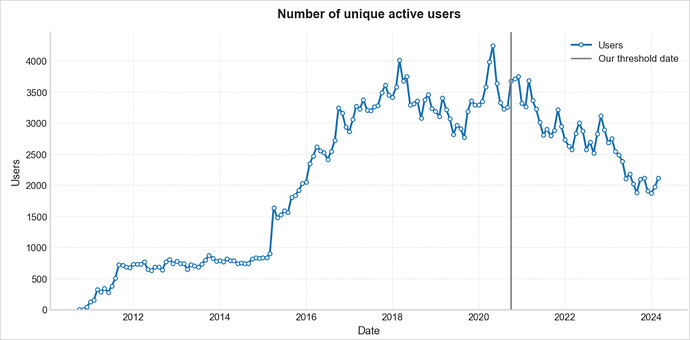I will never stop repeating myself: A healthy community is one that has more users joining than leaving. It is those who find “peers who they want to connect with” among your users and decide to stay who become what we proudly call “community.”
User churn is a natural tendency that any community has. Yes, churn is unavoidable, but what if we try to significantly reduce it? Different industries have many different approaches to working with user churn, but absolutely everywhere we start with identifying users and contacting them.
How to identify users who may churn to contact?
In retail, for example, companies proactively track regular customers and if they see signs of a churn, they offer discounts and promotions to churning customers. Although participation in an online community generally does not bring direct economic benefits to the users, we can offer them something no less valuable, namely, our attention. If we see that a user’s activity is waning, we can contact them in private messages or by email, and ask their opinion on the latest changes in the community, or talk about any other topic. In the event of a drop in activity among regular, previously super active users, we can send them swag. Or we can organize an offline meetup. Or run some other social initiative.
There are many approaches to reducing churn. Regardless of what you decide to go with, the first step is identifying users to contact. I see three groups of users that we can contact to reduce churn in our communities:
-
Recently left users. These are users who have been active recently (e.g. within the last 30 days), but whom we define as already churned (i.e. the probability of performing an action on the site for them is below a certain threshold).
-
Users who will leave soon. These are users for whom the probability of performing a new action in the community today is above the threshold, but the probability of performing an action after some time (for example, in 30 days) is below the threshold.
-
Users who may leave in the long term. These are users who we define as “not churned” yet and who will probably not leave in the near term (e.g. in 30 days), but we have a reason to believe that they will leave the community within some longer term (e.g. six months).
Note that losing regular super active users is much more frustrating than never seeing a user again who posted only once. So, in each of the three groups above, we should pay more attention to those who are on the site longer and create more posts.
From Words to Action: Some Numbers For Stack Overflow in Russian
Let’s look at the data from a real community, Stack Overflow in Russian, which is publicly available.
Above is the Monthly Active Users chart. The gray line represents the day we’ll be looking at in the data. We won’t be looking at the whole dataset because we want to see how many of the identified users actually left the community.
So, here’s what we get after analyzing community data using our platform:
- The number of active users in the community over the past month is 3,254
- Of these, 43 users are in the “recently left” group. The average expected number of posts in the next six months from one user in this group is 5 but in reality, 33% of them will never publish anything in the community again.
- We classified 846 users as those who will leave the community within 30 days. In reality, 73% of them left the site.
- We identified another 1,771 users as those who may leave the community within six months (in reality, this was 1,071 users or 60%), with an average of 2 expected posts per six months from one user.
The number of posts is unevenly distributed. Many of the users who left published several posts per week. I think we could have kept many of them and got an even better community if we had contacted the users in time… We just didn’t have the time to build the tools to identify them, but you do now!


